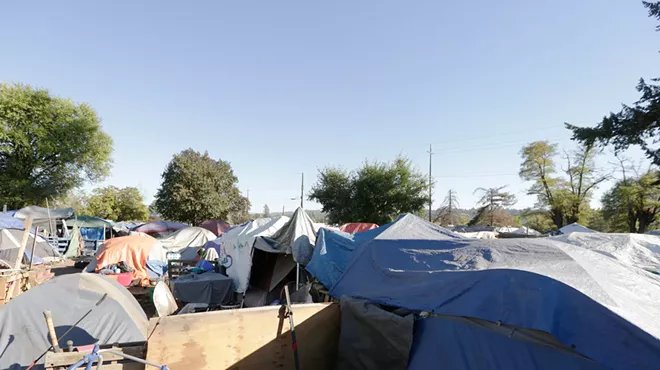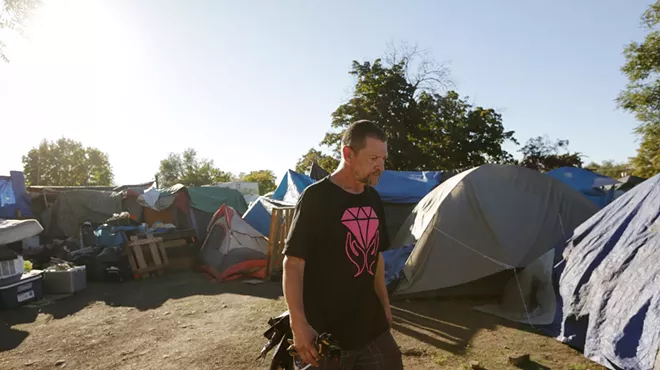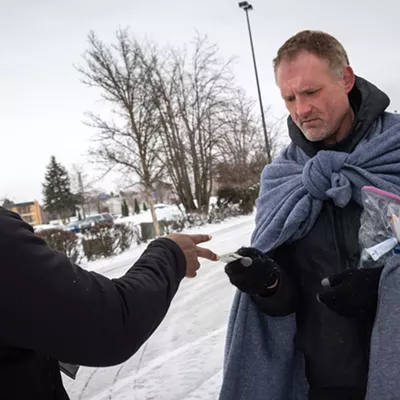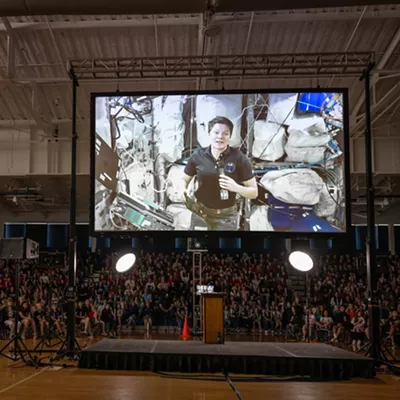If there's one thing the powerful entities fighting over the future of Camp Hope seem to agree on, it's that the camp can't last forever. The debate is about "when" — not "if" — the East Central homeless encampment will come down.
If Spokane County Sheriff Ozzie Knezovich has his way, Camp Hope will end sometime in mid-November. Campers will be offered shelter referrals, out-of-town bus tickets and other resources currently available in Spokane. Those who don't accept will be forced to leave or face arrest.
The Empire Health Foundation, Jewels Helping Hands and state agencies say they want the camp gone too, but only when residents have been assessed and connected to housing and services that fit their individual needs. They argue that offers of bus tickets and congregate shelter beds do little to improve the situation for people facing homelessness, and that clearing the camp on such a short timeframe will just make the situation worse for everybody.
Maurice Smith, who helps manage the camp with Jewels Helping Hands, envisions Camp Hope ending with campers connected to pallet houses, transitional living facilities and low-income housing for the camp's residents. The process will also involve identification restoration, life skills classes and substance use treatment.
Organizers are hesitant to estimate publicly about what a longer-term timeline means. There have been private conversations about it, Smith says, declining to share the details. He does say the camp's cooling tent is being turned into a warming shelter, and that he expects the camp to be there through the winter.
"We're taking this one day, one week and one month at a time," says Smith. "We build plans on reality, not on political rhetoric."
Smith doesn't think the sheriff will follow through on his pledge to clear the camp by mid-November.
Neither does Zeke Smith, the president of Empire Health Foundation, which is doing outreach work at Camp Hope with funding from the state Department of Commerce.
"We're still working on that longer-term timeline," he says. "The goal, from a funding standpoint from Commerce, is ultimately about better housing for people. It's not just about clearing the camp."
SLOW AND STEADY
The slower, more methodical approach resembles the JustCARE model, a multi-agency approach to encampment removal in Seattle. Outreach workers spend weeks visiting camps on an almost daily basis, building trust and getting to know campers so they can be placed in housing or shelter that matches their specific needs.
Chloe Gale, the program director for REACH, a nonprofit involved in the JustCARE model, says the process takes weeks or months, but ultimately results in better outcomes for the campers. When her organization worked to close large encampments in Seattle's Woodland Park and Ballard Commons, a majority of campers ended up in shelters or housing that matched their individual needs. She says that's in contrast to the usual, rapid-displacement approach to encampment removals, which usually just leads to campers being dispersed to other parts of the city.
When encampments pop up in cities, you'll often hear neighbors express impatience and concerns about property crime associated with the camp. Gale says it's still possible to work with the community to address those concerns and gradually decrease the more problematic aspects of an encampment — trash, drug use and property crime — without sweeping the whole thing all at once.
At Camp Hope, volunteers are hoping to address concerns about crime with a chain-link fence erected by the state Transportation Department, which owns the land, on Friday. There's also a new 8 pm to 8 am curfew.
On Sunday afternoon, two men were working to patch holes in the fence. About three openings appeared overnight, pried off with a crowbar. The holes are small, just big enough for an illicit good — or a nimble person — to slip though undetected at night.
As they work to repair the holes, the men explain that they both live at Camp Hope and are employed by Jewels Helping Hands as security team members. Sam Marks has worked security since February. Gary, who asked that his last name not be included, worked security for a period earlier this year, quit and then rejoined the team over the weekend.
The men both seem unphased by the sheriff's pledge to sweep the camp. They don't think he'll actually do it, but if he does, they say they'll just move their camper vans to other parts of the city. They're not interested in going to a shelter.
WHERE WILL THEY GO?
Realistic population estimates for Camp Hope vary wildly, from 350 to 700, but even if you go off conservative estimates, there likely isn't enough shelter space to accommodate everyone in the camp.
"It would be a huge strain on the system," says Mike Shaw, CEO of the Guardians Foundation, which operates the recently opened shelter on Trent Avenue.
That might be beside the point, since many residents say they wouldn't want to go to the current shelters available in the city of Spokane.
"A lot of us can't do shelters," Gary says as he works on the fence. "Like myself, I've tried over the years, and I can't be around that many people."
Gary is talking about trauma related to his military service in the '90s. He also has two dogs — Scout and Pretty Mamas — who wouldn't be allowed into a shelter.
"A lot of us can't do shelters... I've tried over the years and I can't be around that many people."
If it comes down to it, Gary thinks a third of campers would go to a shelter. That's an optimistic estimate. To date, Shaw says about 60 residents have accepted referrals to the Trent shelter. Of those, he says 90 percent stayed. Shaw is working with Knezovich to coordinate the outreach part of the sheriff's plan, and he predicts that 60 more campers will choose the Trent shelter as the weather worsens. Shaw says he's counting on around 200 residents leaving town for warmer cities during the winter. He thinks others will pack up and camp in other parts of the city.
Gale says the key to successful encampment removals that result in residents moving indoors — not just other parts of the city — is desirable options for shelter and other housing. That means bathrooms and privacy, not rows of cots.
SCATTERED
If Camp Hope does get taken down in mid-November, some residents will disperse to shelters across the city. The residents that don't, or can't, accept shelter referrals will move to small camps across the city. Life skills classes, ID replacements, addiction treatment and other services are hard to offer when the people who need them most are miles apart without cars or an easy way to contact them.
"One of the things service providers talk about constantly in terms of what's hard about working with the homeless population is just how transient — how mobile — they are as they're doing their best to meet their needs," Zeke Smith says.
Gale has seen this happen numerous times. She describes encampments that her team spent weeks working with, only to have an abrupt sweep scatter the residents across the city and erase weeks of progress. Gale says some campers who've been lost during sweeps have died while outreach workers were trying to find them.
"It's beyond frustrating," Gale says. "It's really heartbreaking."
Gale says the slow, methodical approach to encampment removals is ultimately better for everyone — campers and neighbors. Even then, the largest encampment her team cleared in Seattle had around 80 people.
"I can't imagine closing an encampment with 600 people in less than six months or a year to be honest," Gale says, "Realistically, I don't know what community we have that can suddenly absorb 600 people inside. I just haven't seen that in Washington." ♦




























